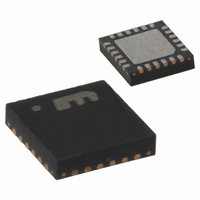MICRF405YML TR Micrel Inc, MICRF405YML TR Datasheet - Page 9

MICRF405YML TR
Manufacturer Part Number
MICRF405YML TR
Description
868-915 MHz ISM Band Transmitter
Manufacturer
Micrel Inc
Datasheet
1.MICRF405YML_TR.pdf
(46 pages)
Specifications of MICRF405YML TR
Frequency
290MHz ~ 980MHz
Applications
ISM
Modulation Or Protocol
ASK, FSK
Data Rate - Maximum
200 kbps
Power - Output
10dBm
Current - Transmitting
18mA
Data Interface
PCB, Surface Mount
Antenna Connector
PCB, Surface Mount
Voltage - Supply
2.2 V ~ 3.6 V
Operating Temperature
-40°C ~ 125°C
Package / Case
24-MLF®, QFN
Operating Temperature (min)
-40C
Operating Temperature (max)
125C
Operating Temperature Classification
Automotive
Product Depth (mm)
4mm
Product Length (mm)
4mm
Operating Supply Voltage (typ)
2.5/3.3V
Operating Supply Voltage (max)
3.6V
Lead Free Status / RoHS Status
Lead free / RoHS Compliant
Features
-
Memory Size
-
Lead Free Status / Rohs Status
Compliant
Other names
576-1965-2
MICRF405YMLTR
MICRF405YMLTR
MICRF405YMLTR
MICRF405YMLTR
April 2006
Writing to the Control Registers in MICRF405
Writing: A number of octets are entered into
MICRF405 followed by a load-signal to activate the
new setting. Making these events is referred to as a
“write sequence.” It is possible to update all, 1, or n
control registers in a write sequence. The address to
write to (or the first address to write to) can be any
valid address (0-29). The SIO line is always an input
to the MICRF405 (output from user) when writing.
Field
Address:
R/W bit:
Values:
How to write:
Bring SEN low to start a write sequence. The active
state of the SEN line is “low”. Use the SCK/SIO
serial interface to clock in “Address” and “R/W” bit
and “Values” into the MICRF405. MICRF405 will
sample the SIO line at negative edges of SCK. Make
sure to change the state of the SIO line before the
negative edge, for instance on positive edge. Refer
to Figure 2.
Bring SEN inactive to make an internal load-signal
and complete the write-sequence. Note: there is an
exception to this point. If the programming bit called
“load_en” (D0 in ControlRegister0) is “0”, then no
load pulse is generated.
Field
Address:
R/W bit:
Values:
How to write:
Micrel
• Bring SEN low
• Use SCK and SIO to clock in the 2 octets
• Bring SEN high
Table 4. When writing to a Single Register, totally 2 octets are clocked into the MICRF405.
Comments
A 7-bit field, ranging from 0 to 29. MSB is written first.
A 1-bit field, = “0” for writing
A number of octets (1-30 octets). MSB in every octet is written first. The first octet is written to the control
register with the specified address (=”Address”). The next octet (if there is one) is written to the control
register with address = “Address + 1” and so on.
Comments
7 bit = A6, A5, …A0 (A6 = MSB. A0 = LSB)
“0” for writing
8 bits = D7, D6, …D0 (D7 = MSB, D0 = LSB)
Table 3. Writing to the Control Registers.
9
What to write:
The two different ways to “program the chip”
are:
Writing to a Single Register
Writing to a control register with address “A6, A5,
…A0” is described here. During operation, writing to
1 register is sufficient to change the way the
transmitter works. Typical example: Change from
transmit mode to power-down.
• The address of the control register to write to (or
• A bit to enable reading or writing of the control
• The values to write into the control register(s).
• Write to a number of control registers (0-29)
• Write to a number of control registers when the
if more than 1 control register should be written
to, the address of the 1st control register to write
to).
registers. This bit is called the R/W bit.
when the registers have incremental addresses
(write to 1, all or n registers)
registers have non-incremental addresses.
MICRF405
(408) 955-1690
M9999-041906











